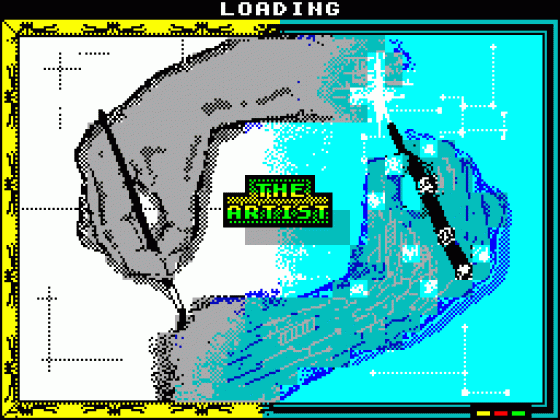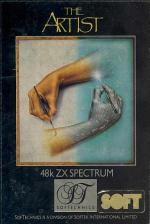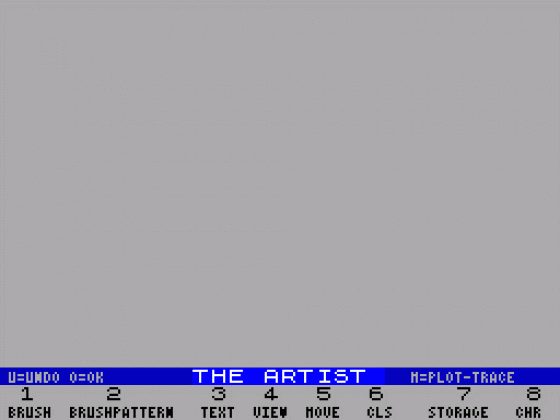
ZX Computing
 1st October 1985
1st October 1985
Categories: Review: Software
Author: Carol Brooksbank
Publisher: Softechnics
Machine: Spectrum 48K
Published in ZX Computing #21
Recently released in competition with Leonardo is Softek's The Artist. Carol Brooksbank tried it out for ZX Computing
The Artist
My artistic talents put me firmly in the 'If-You-Can-Lend-Me-A-Ruler-I-Can-Draw-A-Straight-Line' School of Art, but even I could produce a credible screen after only a short acquaintance with this superb program. Anyone with real ability could produce spectacular work with it, as the examples on the tape show, and the graphics handling alone makes it worth the £12.95 Softek ask for it.
On loading, you are faced with a blank screen, two cursors, and a menu at the bottom of the screen. There are two other menus, and you can flip between them at will. One cursor is the reference cursor, which marks the centre of circles, the start of a line, etc. and the other is the operative one, which you move with the cursor keys. My only quarrel with the program is that three are Q, R, S and T. The handbook says that this is because they make it possible to use fingers to move the cursor and thumbs to change from 'ink' to 'rubber'. That's a nice theory, but most of us are brainwashed into thinking that you use arrow keys for moving things around, and I have lost count of the number of unwanted circles and squares I have produced by trying to move the cursor with keys 5-8. The program makes it easy to rub such things out, but it is irritating. The cursor moves very slowly when held down for short periods, making precise work possible, but if you hold the keys down continuously it speeds up, giving very rapid movement about the screen. There are three cursor modes. One leaves the reference cursor where it is until you move it, the second moves it up to the current position after each line is drawn, and the third makes the cursors follow each other around, so that you can draw arallel lines, or circles and squares of the same size. You can also draw 'freehand' using the operative cursor as a brush.
There are eight brush sizes, from one pixel to one character square, and also an oblique one, which is rather like writing with an italic pen. In addition, you have an 'airbrush' mode for adding stippled shading. The brush can paint with the ink colour, or with one of several shading patterns. The same shading patterns are available for filling shapes, and you can also design your own patterns for this.

The fill operation is faultless. I give it all manner of unlikely shapes to fill with all sorts of shading patterns, and it was perfect every time. You must make sure that the shape you wish to fill is completely enclosed, though. Even a one pixel break in the perimeter will let the shading bleed into the adjoining area. Fortunately, the program shows you the area to be filled before anything permanent is done, so you can trace and seal any gap. The enlarge mode is very useful here, if you are trying to find a one pixel gap.
You can at any point enlarge the drawing to allow you to work with precision on fine details. The window onto the screen moves about as you move the cursor, and you can switch between enlarged and normal size freely. At any time, you can overlay a chequer pattern which shows you the boundaries of the attribute squares, and you can set the attributes one square at a time as you work, or over a larger area if you wish. If you need to work on the bottom two lines of the screen, normally hidden by the menu, you can move the screen up.
There is a cut and paste mode, which allows you to move sections of your work about, copy a section to another part of the screen, or enlarge or reduce portions in either or both directions. If you are producing a symmetrical design, you need only draw half, because the cut and paste mode can produce a mirror copy.
At any point in your work, you can store the current state of the screen in memory, and if you then make a mistake you can return to the stored state. I found it useful to supplement this with the occasional tape saving, however, as the stored memory is automatically updated after cut and paste or fill.
Finally, there is a text mode with a choice of typefaces, including Gothic, and a very good small typeface which is clearly readable even in a screen dump.
The program's UDG handling is superb. There are eight sets of graphics defined in the program and you can redefine seven of them, the eighth being the Sinclair character set. You have to be careful which you redefine, because all the shading patterns and typefaces are held in the graphics sets. The program itself makes use of the small typeface, and if you redefine that the menus start to look a bit odd.
The graphic defining grid allows you to define a figure which covers up to nine character squares, and which can then be manipulated. You define on an enlarged grid, but there is a normal size box alongside, so that you can judge the finished effect. You can save the finished figure in memory and print it to the screen. You can also pick up figures already on the screen if you wish to modify them. This means that you can, if you wish, define figures even larger than nine squares. You draw them on the screen as part of your overall design, and then pick them up from the screen in blocks of nine squares and store them in the graphics memory and/or on tape, microdrive or wafa.
If you are intending to animate a graphic you can define up to four related figures, and the program will show you the animation effect, by printing them rapidly one after the other in the box beside the grid.
The graphics mode can also be used to define your own shading patterns or character sets, and the program comes with a set of useful characters, including an aeroplane, helicopter, and tank, and a man with a gun who can be animated so that he runs along shooting.
All the character sets and your screens can be saved on tape. The program is microdrive compatible, and claims to be Wafadrive-compatible, though I found that you had to tinker with the Basic a bit before you could save and load freely to Wafadrive. There is a compressor program on the tape, allowing you to compress all, or part, of your screens, store and recall them by number when required. Screen dumps to ZX printers are provided for, and I found that a very minor alteration to the Basic allowed me to produce screen dumps with my Epson printer and Kempston interface. The range of shading available in the program makes it particularly useful for producing small line-drawing illustrations on the printer.
The publishers invite you to register with them as an owner of The Artist, so that you will be entitled to discounted copies of future enhanced versions, and they offer a printing service. Send them a tape of your screen and they will provide colour printouts at prices ranging from 75p for a one-off 3" wide to £2 for 8" wide. Multiple copies are a bit cheaper.
I would recommend The Artist to anyone who wants to produce artwork with the Spectrum, amateur or professional. However good (or bad) you are as an artist, this program will help you to produce very elaborate screens better and more quickly than you thought possible. It is not often that you come across a program which so splendidly lives up to the claims the publishers make for it.
Other Reviews Of The Artist For The Spectrum 48K
The Artist (The Edge)
A review by (Crash)
The Artist (Softek)
A review by John Gilbert (Sinclair User)
The Artist (Softechnics)
A review







